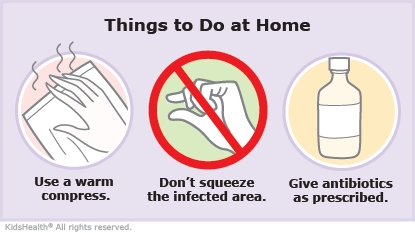Mastitis (Breast Infection): How to Care for Your Child
Antibiotics usually clear up a breast infection and help babies with mastitis feel better.


Mastitis is a breast infection that is usually caused by bacteria (a type of germ) that enters the body through a cut or scratch in the skin of the breast. The infected area may be painful, red, warm, and swollen. Sometimes there is discharge from the nipple. Babies with mastitis may be fussy, develop swollen glands (lymph nodes) under the arms, or have a fever.
A breast infection happens most often in full-term babies in the first 2 months of life and in women who are breastfeeding. Rarely, older children or adolescents develop mastitis. Usually the infection happens in only one breast.
The health care provider talked to you and did a careful examination of your baby. If there was drainage from the nipple, a sample of it was sent to the lab to test for the type of bacteria causing the infection. Depending on your baby's age, how sick he or she was, and if there was a fever, health care providers may have checked for infection in other parts of the body.
Sometimes a skin abscess (a pus-filled area) forms under the skin of the breast and pus needs to be taken out and tested for infection.
While in the hospital, your baby was given intravenous (IV) antibiotics to treat the breast infection. Your baby is doing better and if tests were sent, they did not show any other infections. It is now safe to give the antibiotic by mouth and care for your baby at home.

-
Make sure your baby finishes all of the antibiotics as directed by the health care provider even if your baby seems better in a few days.
-
If your infant is uncomfortable, you may give acetaminophen to help your child feel better.
-
Avoid touching or squeezing the infected area.
-
Your health care provider may recommend putting a warm compress on the breast area. Wet a washcloth with warm (not hot) water and place it on the skin for 15–20 minutes four times a day or as directed.
-
Check the infected area every day for worsening redness or swelling.
-
Schedule all follow-up appointments as directed.

Your infant:
-
Has increased redness, swelling, or pain.
-
Is not able to take the medication.
-
Does not continue to improve after following the health care provider's instructions.
-
Is not able to feed well.
-
Appears to be dehydrated; signs include a dry mouth, few or no tears when crying, more than 4–6 hours without a wet diaper, sunken eyes or soft spot on the head, decreased alertness, rapid breathing, and/or excessive sleepiness.

Your infant:
-
Has a new or increased fever.
-
Develops red streaks spreading from the infected area.
-
Has new or increased liquid draining from the breast.
-
Has new or increased swelling.
-
Seems to be getting worse or seems very ill.